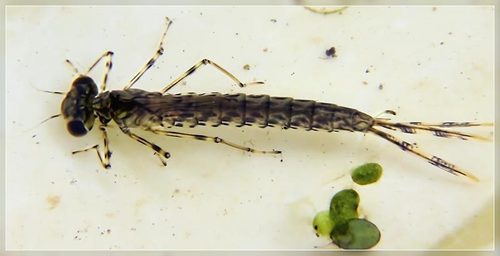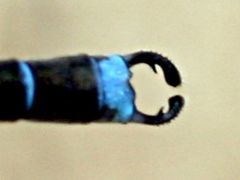Blue Damselfly
Austrolestes colensonisSummary 7
Austrolestes colensonis, (Māori: kekewai) is a common native New Zealand damselfly.
Description - adults 8
The largest NZ damselfly, 40-47mm long. Dark legs with a pale stripe down the lower half. Blue eyes.
Male: Black abdomen with narrow bright blue rings, and a bright blue patch on the last segment. Tail slightly clubbed in the male, more so in the female. When cold the blue colours are a dull purple. Female, and immature males, may have a greenish sheen; in males this disappears as they mature, and they become definitely black.
As with most damselflies there is a downward bulge in segment two (the first segment fully visible after the thorax) of a male, and the abdomen narrows then widens again towards the tail. The claspers on the end of the tail are usually very obvious.
The wing spots are brown and 3 times longer than wide.
On the 'neck' there are three consecutive pale blue spots of diminishing size:
Segment two (the first segment fully visible after the thorax) of a male :

The last two segments of the male abdomen (view from above and side) :
Female: Colour patterns similar to those in the male. Black areas in the female are a dark green-black and have a green sheen especially in younger animals. The pale markings are generally bright yellow-green; however at high temperatures they change to pale blue. Abdomen much thicker than in the male and distinctly clubbed at the end.
The last three segments of the female abdomen (view from side) :
The males tend to stand with their abdomen at right angles to the vertical stalks that they rest on. Or at 60 degrees to it if not being territorial, and the abdomen may sag below the wings. The wings may be held to the side of the abdomen away from the sun.
Description - nymphs 8
Their bodies are long and narrow with more distinct stripes across the abdomen at each segment compared to red damselflies which have a wider/shorter body.
They are streamlined swimmers which dart around everywhere when disturbed, whereas red damselflies waggle dramatically side to side.
References 8
The dragonflies of New Zealand by Rowe, R.J. [contributions by Corbet, P.S. ; Winstanley, W.J.] 1987. PDF
Identification notes left by Tanya Dann in comments on NatureWatch, and descriptions from her interview on radionz: damselflies-fast-blue-and-slow-red.
Sources and Credits
- (c) Jon Sullivan, some rights reserved (CC BY), http://www.flickr.com/photos/16921893@N00/7936008640
- (c) Tony Wills, some rights reserved (CC BY-NC-SA), uploaded by Tony Wills
- (c) Tony Wills, some rights reserved (CC BY-SA), uploaded by Tony Wills
- (c) sea-kangaroo, some rights reserved (CC BY-NC-ND), uploaded by sea-kangaroo
- (c) Grahame, some rights reserved (CC BY-NC-ND), uploaded by Grahame
- (c) Tony Wills, all rights reserved, uploaded by Tony Wills
- Adapted by Tony Wills from a work by (c) Wikipedia, some rights reserved (CC BY-SA), http://en.wikipedia.org/wiki/Austrolestes_colensonis
- (c) Tony Wills, some rights reserved (CC BY-SA)













